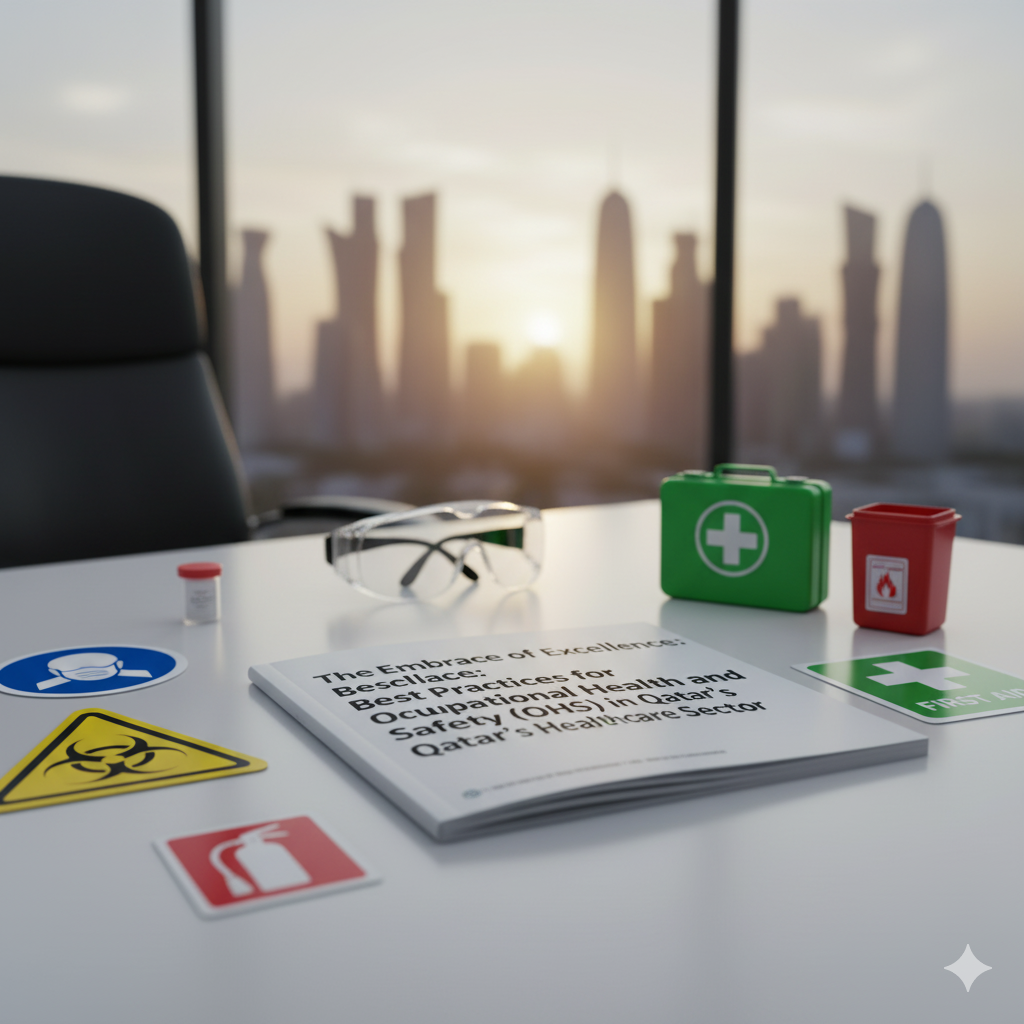The Embrace of Excellence: What are the Best Practices for Occupational Health and Safety (OHS) in Qatar’s Healthcare Sector?
The healthcare sector in Qatar is a dynamic, high-growth environment, rapidly expanding to meet the needs of a diverse and increasing population. With this rapid expansion, the focus on providing a world-class standard of care extends beyond the patient to the very foundation of the system: its people. Occupational Health and Safety (OHS) is not merely a regulatory requirement; it is a moral imperative and a strategic asset that underpins the entire healthcare ecosystem. An effective OHS program is a testament to an organization’s commitment to its staff and patients, ensuring a resilient and sustainable healthcare workforce. At Embracive EHS Solutions LLC, we believe in a holistic and comprehensive approach to OHS—one that proactively integrates safety into every facet of a healthcare facility’s operations.
The Unique Landscape of Healthcare OHS in Qatar
Qatar’s healthcare system is characterized by its rapid modernization and unique demographic makeup. The nation's strategic vision, embodied in the Qatar National Vision 2030, has led to significant investment in advanced medical facilities and technologies. This ambitious growth, however, introduces specific OHS challenges:
- Diverse Workforce: A significant portion of Qatar’s healthcare workforce comprises expatriates from various countries. This rich diversity can present challenges in communication, cultural norms, and different levels of prior safety training.
- Evolving Regulations: Unlike some countries with a single, comprehensive OHS law, Qatar’s health and safety regulations are spread across a variety of laws and decrees. Navigating this multi-faceted legal landscape requires specialized expertise to ensure full compliance.
- High-Risk Environment: Healthcare is inherently a high-risk industry. Workers are exposed to biological hazards (pathogens, infections), chemical hazards (medications, cleaning agents), physical hazards (slips, trips, falls, ergonomic issues), and psychosocial stressors (burnout, long hours, emotional strain).
To overcome these challenges, a truly embracive OHS strategy is essential. It must go beyond mere checklists and foster a culture of safety that is embedded in the daily work of every individual, from the hospital administrator to the front-line nurse.
Core Pillars of Proactive Healthcare OHS: A Guide to Best Practices
A successful OHS program is built on a foundation of several interconnected pillars. At Embracive EHS Solutions LLC, we focus on these key areas to help our clients achieve excellence in their safety performance.
1. Leadership and a Robust Safety Culture
The most effective OHS programs are those driven from the top down. Leadership must be visibly and actively committed to safety. This means:
- Clear Vision and Policy: Developing and communicating a clear OHS policy that outlines the organization's commitment to protecting its employees and patients.
- Accountability: Establishing clear roles and responsibilities for OHS at every level of the organization. This ensures that every individual understands their part in maintaining a safe environment.
- Proactive Communication: Encouraging open dialogue where employees feel empowered to report hazards or unsafe practices without fear of reprisal. A "STOP Card" or similar system, where any worker can halt an activity they deem unsafe, is an excellent example of this in practice.
A strong safety culture fosters a sense of shared responsibility and promotes a holistic view of well-being, where physical, mental, and emotional health are all prioritized.
2. Comprehensive Risk Management and Hazard Control
Risk management is the cornerstone of any OHS program. For healthcare, this requires a systematic and ongoing process to identify, assess, and mitigate hazards.
- Hazard Identification and Risk Assessment (HIRA): Regularly conduct HIRA to identify potential hazards in all departments, from the surgical ward to the laundry room. This includes:
- Biological Hazards: Implementing protocols for handling bloodborne pathogens, infectious waste, and sharps disposal.
- Chemical Hazards: Ensuring proper storage, handling, and labeling of chemicals (e.g., disinfectants, cytotoxic drugs) and providing appropriate personal protective equipment (PPE).
- Physical Hazards: Conducting ergonomic assessments of workspaces to prevent musculoskeletal injuries, managing noise levels, and ensuring fire safety and emergency preparedness.
- Psychosocial Hazards: Addressing the risks of stress, burnout, and violence against healthcare workers through support programs, workload management, and de-escalation training.
- Job Safety Analysis (JSA): For high-risk procedures or tasks, a JSA should be conducted. This process breaks down a job into individual steps, identifies the hazards associated with each step, and outlines the controls needed to mitigate those risks. This is particularly effective for procedures like handling medical waste, operating specialized equipment, or performing maintenance in patient areas.
3. Tailored Training and Education
Given the diverse workforce in Qatar, an integrated approach to training is paramount. Training must be accessible, culturally sensitive, and relevant to the specific roles and responsibilities of each employee.
- Onboarding and Induction: New employees should receive comprehensive OHS training during their induction, covering general safety policies, emergency procedures, and an introduction to the specific hazards of their work area.
- Continuous Learning: OHS training should not be a one-time event. Regular refresher courses, toolbox talks, and departmental meetings should be used to reinforce safety protocols and address new or emerging risks.
- Language and Cultural Sensitivity: Training materials should be available in multiple languages, and trainers should be aware of cultural nuances that might affect the understanding and adoption of safety practices.
4. Promoting Health and Wellness
True OHS goes beyond preventing accidents; it promotes the overall health and resilience of the workforce. This includes both physical and mental well-being.
- Proactive Health Monitoring: Establish programs for health screenings, vaccinations, and exposure monitoring (e.g., for chemicals or radiation).
- Ergonomics Programs: Provide ergonomic assessments and education to reduce the incidence of back pain and other musculoskeletal disorders, a common issue in healthcare.
- Mental Health Support: Create an environment that destigmatizes mental health challenges. This includes providing access to counseling services, offering stress management workshops, and promoting a healthy work-life balance. A healthy and happy workforce is a safer workforce.
5. Leveraging Technology and Data
Technology can be a powerful tool for enhancing OHS. Modern healthcare facilities in Qatar can leverage digital solutions to create a more efficient and effective safety program.
- Digital Reporting Systems: Implement digital systems for reporting incidents, near misses, and safety observations. This provides real-time data that can be used to identify trends and address potential risks before they lead to an accident.
- Performance Analytics: Use data to track key performance indicators (KPIs) like incident rates, days without a lost-time injury, and the number of safety observations. This data allows for continuous improvement and helps demonstrate the value of the OHS program to stakeholders.
- E-Learning and Simulation: Utilize e-learning modules and virtual reality simulations for OHS training, especially for high-risk procedures, allowing employees to practice in a safe and controlled environment.
The Embracive Approach: A Partnership in Safety
At Embracive EHS Solutions LLC, our mission is to empower healthcare organizations in Qatar to achieve and exceed their safety goals. We provide a comprehensive suite of services, from expert-led on-site audits and inspections to the development of custom-tailored OHS programs. Our approach is built on the principles of collaboration, continuous improvement, and the unwavering belief that safety is a shared responsibility. We work alongside your team to identify hazards, streamline processes, and ensure full compliance with local and international standards, including the rigorous requirements of healthcare accreditation bodies.
Through our dedicated services, we help our clients create a truly embracive safety culture—one that protects people, assets, and the environment. We help you transform safety from a regulatory burden into a source of competitive advantage and an essential component of quality patient care.
Frequently Asked Questions (FAQs)
1. What is the difference between OHS and HSE?
OHS (Occupational Health and Safety) focuses specifically on the health and safety of people in the workplace. HSE (Health, Safety, and Environment) is a broader term that also includes protecting the natural environment from the organization's activities.
2. Is OHS mandatory for healthcare facilities in Qatar?
Yes. While there isn't one single law, various laws and regulations, including the Qatar Labour Law, mandate that employers provide a safe and healthy work environment. Furthermore, achieving international accreditation (e.g., JCI) requires a robust OHS program.
3. How can we ensure our expatriate workers understand our OHS policies?
Providing OHS training and materials in the native languages of your workforce is a best practice. Additionally, using visual aids, hands-on demonstrations, and encouraging a culture of asking questions can help overcome language and cultural barriers.
4. What are some of the most common OHS risks in a hospital setting?
Common risks include sharps injuries, exposure to infectious diseases (e.g., from blood or other bodily fluids), chemical exposure from disinfectants or medications, back injuries from lifting patients, and burnout or stress from a high-pressure environment.
5. How can technology improve our OHS program?
Technology can enhance OHS by providing real-time data on incidents, streamlining reporting processes, automating compliance checks, and offering interactive training platforms. This moves the safety program from reactive to proactive, allowing for quicker and more effective risk mitigation.
6. How often should we conduct OHS audits and inspections?
Regular OHS audits and inspections are crucial for continuous improvement. While there is no single rule, a common practice is to conduct internal inspections at least quarterly, with a full third-party audit performed annually to identify areas for improvement and ensure compliance.
7. Can Embracive EHS Solutions LLC help with a customized OHS program for our facility?
Absolutely. We specialize in developing and implementing customized OHS management systems that are uniquely tailored to the specific needs and risks of your healthcare facility in Qatar. Our goal is to partner with you to build a proactive and sustainable safety culture.

